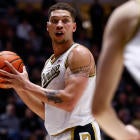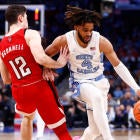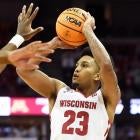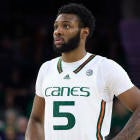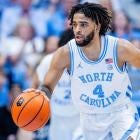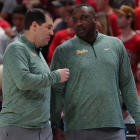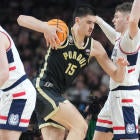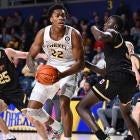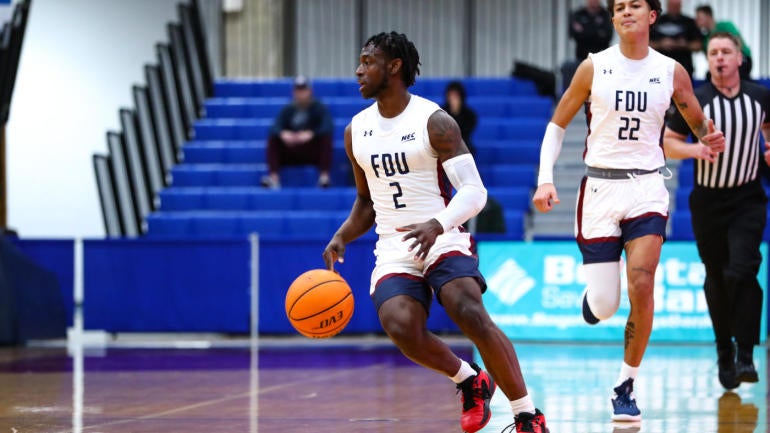
Note: This story on Fairleigh Dickinson originally appeared on CBSsports.com in February as the team was midway through conference play in its first season under coach Tobin Anderson. Since then, the Knights secured the NEC's automatic bid to the Big Dance and won First Four game and were then matched up against Purdue. The game pitted FDU's tiny lineup against the Boilermakers and their 7-foot-4 center, Zach Edey. For a program coming off a 4-22 season, even making it to the Big Dance marked a stunning turnaround, and pushing Purdue to the brink only validated the incredible nature of the program's turnaround.
HACKENSACK, N.J. – Any college basketball fan who remembers Loyola-Chicago's opening night win over Fairleigh Dickinson likely remembers it for the absurdity of the full-court pass and Christian Laettner-esque, buzzer-beating jump shot from the Ramblers' Sheldon Edwards that tied the game at the end of regulation.
Loyola-Chicago proceeded to win 88-82 in an overtime game that had Sister Jean's divine touch written all over it. On a dull opening night of college basketball void of marquee matchups, it was one of the highlights.
Three months later, the game remains fresh in the mind of first-year Fairleigh Dickinson coach Tobin Anderson for another reason. Though Edwards' shot at the end of regulation still haunts him and solicits an eye roll, his team's competitiveness that night stands out as a sign of the good coming FDU's way.
"I was worried going into the first game that our size would hurt us," Anderson said. "Loyola was kind of like the first test. It's an A-10 school, their place, packed house and our guys were not flustered at all."
Heading to OT on opening night! pic.twitter.com/CNkL6Iapo7
— Loyola Men's Basketball (@RamblersMBB) November 8, 2022
Anderson was right to be concerned. After a prolific nine-year run at Division II St. Thomas Aquinas College, he inherited a team that finished 4-22 last season and proceeded to construct one of the smallest rosters in the modern era of Division I college basketball.
With an average height of just over 6-foot-1, FDU is this year's shortest team by a wide margin, and there has been just one shorter squad in college hoops since kenpom.com began charting average height in 2006-07.
But it's because of the Knights' starting backcourt of 5-8 Demetre Roberts and 5-9 Grant Singleton – not in spite of it – that the country's tiniest team is in the midst of a massive turnaround.
At 14-11 and 7-3 in the Northeast Conference, Fairleigh Dickinson is a half game out of first-place in the conference standings with Roberts and Singleton ranking third and seventh, respectively, in the NEC in scoring.
The diminutive duo followed Anderson from St. Thomas Aquinas and is combining for 31.8 points per game. In large part because of their leadership, the Knights are poised to potentially quadruple last season's win total this week.
Over the past 16 years entering this season, the shortest teams in Division I won just 44.5% of their games. The only team on record in the KenPom.com era shorter than Fairleigh Dickinson was the 2009-10 Grambling State team that finished 7-21. The 2014-15 UMass Lowell team was equally as small as FDU and finished 12-17.
But with a unique style of play centered on pace and tempo, Fairleigh Dickinson is defying those historical norms.
"We get up and down the court," Singleton said. "Most teams that have a 7-foot big man, we beat them down the court and make them run. A lot of teams can't run with us, so that's our advantage."
Even FDU's bigs aren't big. The tallest players logging regular minutes are Ansley Almonor and Jo'el Emanuel, who are both listed at 6-foot-6 on the team's official roster. Predictably, the Knights block just 1.8 shots per game, which ranks 343rd nationally.
But what FDU lacks in rim protection, it makes up for with relentless pressure and offensive volume. Only 11 of 363 teams in Division I attempt more shots per game than the Knights, who force 16.3 turnovers per game while playing at breakneck pace.
"Obviously we're small — we're the smallest team in the country — so we try and use our speed," Roberts said. "We press the whole game, and that speaks for itself. We try and wear everybody down."
So how did Fairleigh Dickinson go from four wins to conference title contention with such an undersized group in one season? The story starts at St. Thomas Aquinas, which is just 25 minutes north of Fairleigh Dickinson in Sparkill, New York.
Altered plans
Anderson, 51, is a coach's son from the tiny town Truro, Iowa. He is proud of his Midwestern roots, though they are undetectable in his accent after decades spent grinding at Division II and Division III jobs in the Northeast.
He is a fast talker and basketball savant who looks perfectly at home in an office overlooking Fairleigh Dickinson's home court at the Rothman Center along the Hackensack River just 10 miles from Manhattan and a world away from his upbringing.
As he reflects on the journey that finally brought him to a long-awaited Division I opportunity at Fairleigh Dickinson, there is one thing about his relationship with Roberts and Singleton that renders him briefly speechless
"What's the word I'm looking for?" Anderson asked before finally settling on "belief."
"The belief they had in me, it means a lot to me," he said. "Because they came along into a situation where they had no idea what they were stepping into."
After going 92-19 in four seasons together at St. Thomas Aquinas and making three Division II Sweet 16 appearances under Anderson, both guards took some time off after the 2021-22 season to decide whether or not they wanted to return for a fifth and final season made possible because of the COVID-19 pandemic.
They both decided they would return to St. Thomas Aquinas. Then Anderson threw a wrench in the plan.
A full two months after Fairleigh Dickinson's 2021-22 season ended, the school announced Greg Herenda would not return as coach. It wasn't until early May that FDU hired Anderson, who had his own reservations about leaving a thriving Division II program to take over a struggling FDU program at a point in the calendar when building a competitive 2022-23 roster would be a challenge.
"After talking to people and doing my homework and asking around, there was enough stuff here that I thought you could win here," Anderson said. "I thought you could win here in probably three years. I think that was the reality depending on the roster and who was back. So, obviously, this year has been a pleasant surprise.
"If I say no, who knows if I get asked again?"
Roberts acknowledged that "emotions started to build up" when Anderson left for Fairleigh Dickinson after they'd already begun setting the wheels in motion for a run at the 2022-23 Division II national title.
Both Roberts and Singleton grew up dreaming of playing at the Division I level and got the opportunity when they least expected it — at the 11th hour of their college careers with one of the coaches who had believed in them as high school prospects.
But leaving a place where they'd built legacies to go join a team coming off a 4-24 season was not an easy decision.
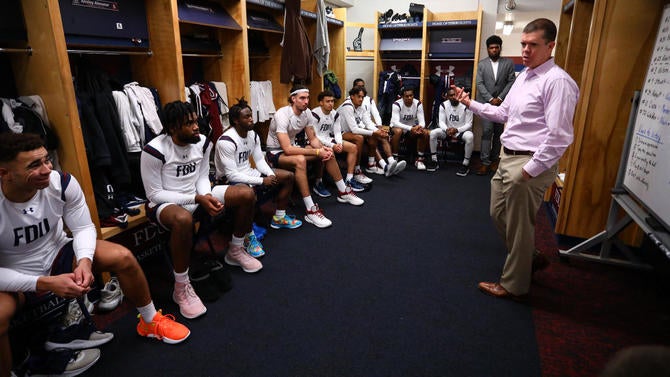
"They were both upset," Anderson said. "Put yourselves in their shoes at 22 years old. For six weeks, they'd been planning on coming back next year, and then I took this thing and turned it upside down…But I think the competitive fire for those guys and wanting to prove themselves on this level was probably overwhelming, and the fact that we have a good relationship. It's been a lot of fun and we've won a lot of games. Those guys took a chance on me."
Roberts and Singleton had been committed to returning to St. Thomas Aquinas and could see the rebuild required at Fairleigh Dickinson. But they also knew the architect of the rebuild.
"Everything happened so fast," Roberts said. "But when you sit back, you've got to think about the opportunities a coach can get, and he's succeeded everywhere he's been. Then for him to have an opportunity to bring us, everything started to cool down."
The Knights started 3-6 but then raced to a 5-0 start to begin NEC play as a mixture of returning players, former St. Thomas Aquinas players and collegiate newcomers began to gel. Roberts and Singleton have offered their teammates a blueprint for how Anderson wants to play, as has fellow former St. Thomas Aquinas guard Sean Moore, who is FDU's leading rebounder at 6-4 and 175 pounds.
"Our voice does a lot, but we've got to come to practice and to games every day ready to play and ready to compete and they can pick up after us," Singleton said. "Once we leave, this is their program, so just leading by example and showing what hard work really looks like."
Big year for small guards
Just three players listed under 6-feet tall have appeared in an NBA game this season, and none of them are regular members of a team's rotation. If that number holds, it will mark the fewest sub-6-footers to play in the NBA during a single season since at least 1996-97, which is the last year of available data in the NBA Advanced Stats database.
In an era of positional versatility and defensive switching, the little guys are getting squeezed out at the game's highest level. By comparison, there were 13 players under 6-feet tall who played in the NBA during the 1997-98 season, and six of them played 70 or more games.
But in college basketball, there is still a home for short guards. Of the nation's top 350 assists leaders, 45 of them are under 6-feet tall. Of the top 350 scorers, 19 are under 6-feet tall, which is right in line with the rates of undersized scorers the sport has produced over the past decade.
No. 6 Tennessee, No. 7 UCLA, No. 8 Virginia and No. 12 Kansas State each start guards under 6-feet tall. Though none of them were highly touted prospects, all have proven to be integral players for programs with national title aspirations.
Kansas State's Markquis Nowell, a 5-8 senior, is leading a stunning renaissance at K-State that has the Wildcats as a projected No. 2 seed for the NCAA Tournament in Jerry Palm's Bracketology. He is sixth in the Big 12 in scoring at 16.8 points per game and is third nationally in assists per game at 7.8 after ranking No. 223 in the Class of 2018 and beginning his career at Little Rock.
Zakai Ziegler, a 5-9 sophomore for Tennessee, is second in the SEC in assists per game at 5.1 and tied for fourth in steals at 2.1 after ranking as the No. 274 prospect in his class. Tyger Campbell, a 5-11 UCLA senior, ranks fourth in the Pac-12 in assists per game at 4.9 and is the Bruins' second-leading scorer at 13.1 points per game after ranking as the No. 87 prospect in his class.
Little big men
How the shortest teams each season in college basketball since 2006 have fared.
| Season | Team | Avg. Height | Record |
|---|---|---|---|
| 2022-23 | Fairleigh Dickinson | 6-1.4 | 14-11 |
| 2021-22 | Abilene Christian | 6-2.3 | 25-11 |
| 2020-21 | New Orleans | 6-2.6 | 10-15 |
| 2019-20 | Niagra | 6-2.1 | 12-20 |
| 2018-19 | UT Arlington | 6-2.5 | 17-16 |
| 2017-18 | The Citadel | 6-2 | 11-21 |
| 2016-17 | Texas Southern | 6-2.4 | 23-12 |
| 2015-16 | Bethune Cookman | 6-2.6 | 14-18 |
| 2014-15 | UMass Lowell | 6-1.4 | 12-17 |
| 2013-14 | UMass Lowell | 6-2.1 | 10-18 |
| 2012-13 | Texas Southern | 6-1.9 | 17-14 |
| 2011-12 | Charleston Southern | 6-2.2 | 19-12 |
| 2010-11 | Prairie View A&M | 6-2.1 | 10-22 |
| 2009-10 | Grambling State | 6-1.1 | 7-21 |
| 2008-09 | Nebraska | 6-1.8 | 18-13 |
| 2007-08 | Ball State | 6-1.8 | 6-24 |
| 2006-07 | Chicago State | 6-2.3 | 9-20 |
-- Source: KenPom.com
Kihei Clark, a 5-10 fifth-year senior, played a key role on Virginia's 2019 title team as a freshman after ranking No. 378 in the 247Sports Composite. He is second in the ACC this season in assists per game at 6.0 and is 22nd nationally with a 2.8 assist-to-turnover ratio
Between Clark and former 5-11 guard Jontel Joiner, Virginia coach Tony Bennett has played an undersized guard in his lineup for nine of his 14 seasons with the Cavaliers. He'll have another one in his rotation next season when Georgetown transfer Dante Harris joins the rotation after being listed at just 5-10 and 145 pounds on his 247Sports profile from the Class of 2020.
"Perhaps we fall in love with dimensions, with size, with certain attributes," Bennett said. "But can you measure the heart and the mind and feel for the game and skill? Those things often get overlooked when it comes to impacting a game. And it usually plays out in terms of impact on a program and then long-term success."
'All that's right about college basketball'
That has rung true for Anderson with Roberts and Singleton, first at St. Thomas Aquinas and now at Fairleigh Dickinson. He can remember watching both of his undersized guards standing out as the best players on the floor at times during AAU games with plenty of college coaches watching.
"But I think because of their size, people just didn't want them," he said.
Roberts initially resisted attention from Anderson at St. Thomas Aquinas as he held out for a Division I offer, and Singleton felt fortunate to get an offer at all.
They both ended up signing with Anderson at St. Thomas Aquinas and became roommates. They are still roommates to this day and credit their off-the-court bond for why things work so well on the court.
Roberts cites Nate Robinson, Kemba Walker and Isaiah Thomas among the players he's modeled his game after, while Singleton first studied the likes of Rajon Rondo, John Stockton and Penny Hardaway. As he's honed his 3-point shot in recent seasons, he's watched more Stephen Curry and Klay Thompson.
Both aspire to play professionally after this season. Their recruitments were quiet and their statures are limited. But all Roberts and Singleton have done in their college careers is win.
"I feel like as a basketball player and a smaller guard, we tend to listen to the outside noise," Roberts said. "That can mess up your confidence on what you can really do. So us both, we just try and navigate through it all."
If the Knights emerge as NEC Tournament champions, they will head to the sport's ultimate proving ground: the NCAA Tournament. A potential matchup for FDU there would be Purdue, which is on track to be the No. 1 overall seed behind the play of star 7-4 center Zach Edey.
Anderson chuckles at the hypothetical scenario, acknowledging that the postseason remains "a long way down the road."
"We double the post now, but we'd probably have to triple the post in that situation, bring the whole world at 'em," he said. "If we ever had a chance to do that, it would be awesome."
Big Dance or not, Year 1 at Fairleigh Dickinson will go down as a success for Anderson thanks to the unheralded, undersized and overlooked tandem leading the nation's smallest team to a stunning turnaround.
"They're all that's right about college basketball," Anderson said. "They really are. They're great kids that want to prove themselves. I think it proves that there are a lot of small college players and coaches that can succeed at this level, which is great."













